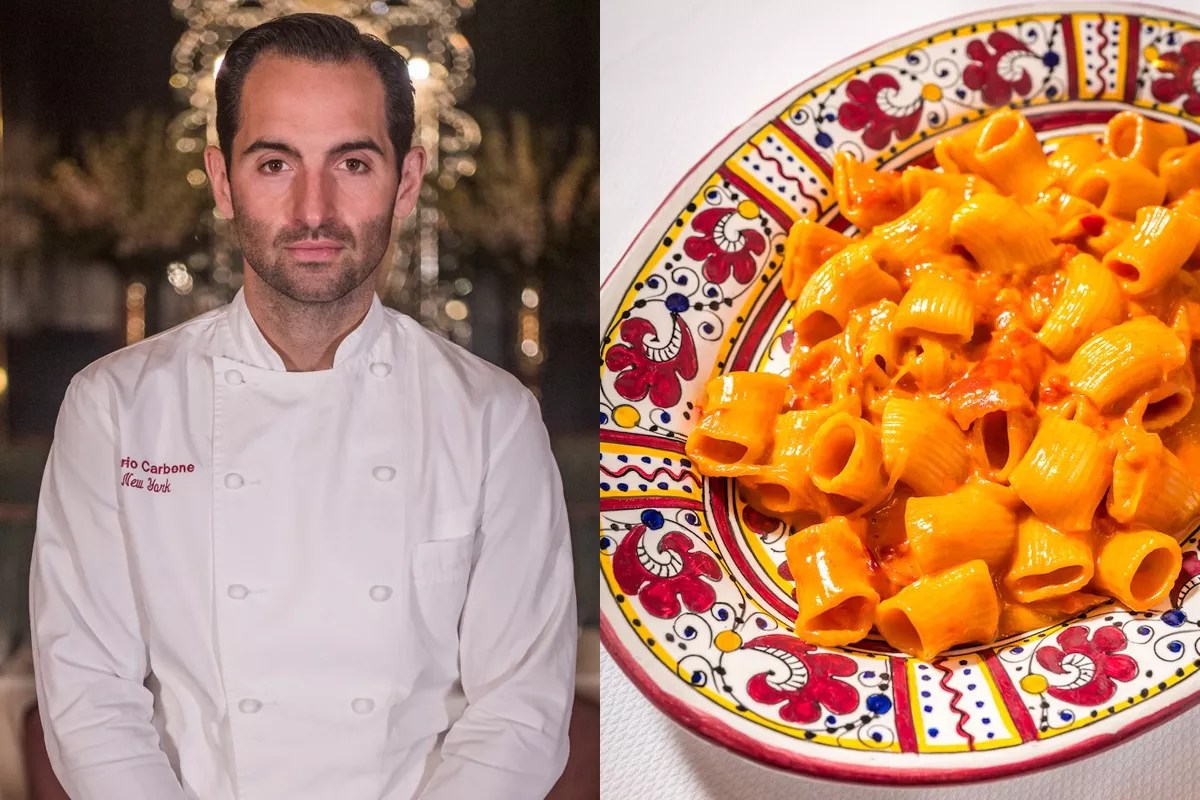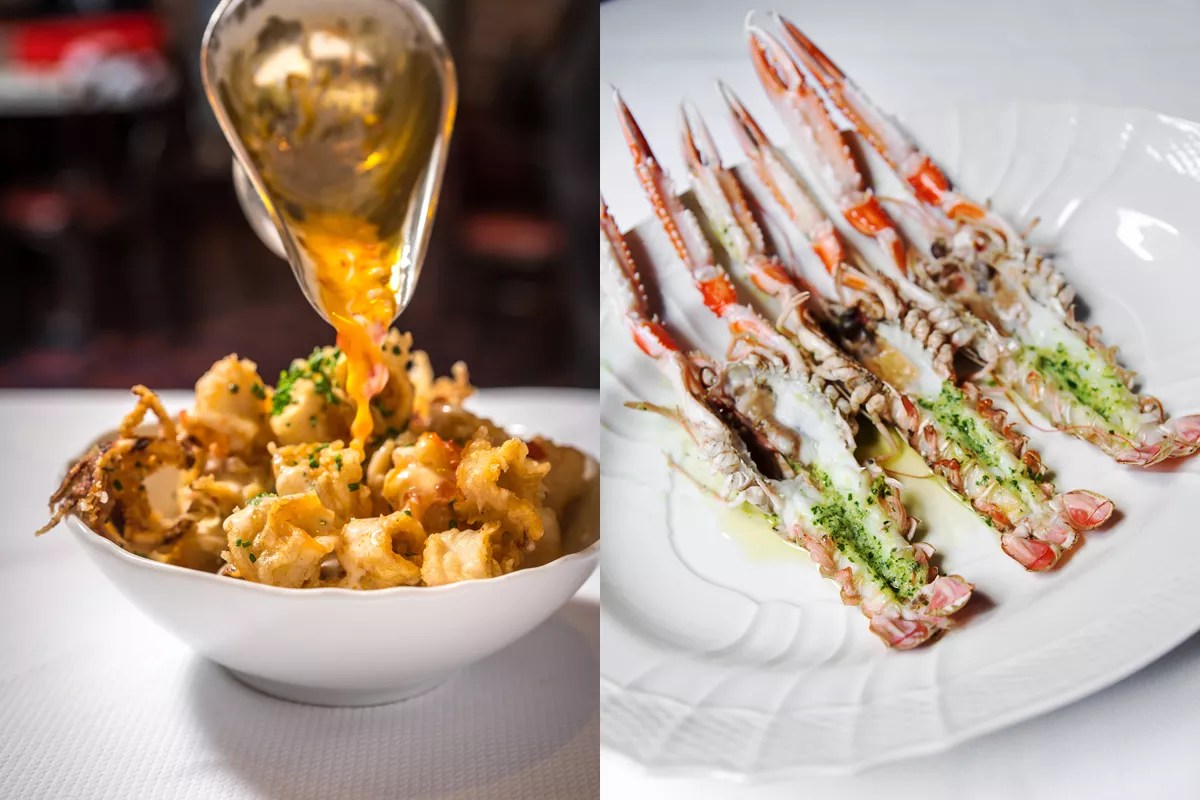
Photo by World Red Eye/Seth Browarnik/Courtesy of Carbone

Audio By Carbonatix
Fashion is cyclical. Trends have a life, they die, and then – at some point – experience a rebirth. Take acid-wash jeans, for instance. In the 1980s, everyone from Madonna to tennis star Andre Agassi wore them. Then they were ostracized as “uncool.” But a trip to any department store today will find an ample supply of acid-wash “mom jeans,” there to be scooped up by “on trend” social-media fashionistas.
Food, like fashion, also has its moments. Dishes like beef Wellington or a caesar salad prepared tableside are considered “trite” until a chef like Thomas Keller puts a stunning rendition on his menu at the Surf Club Restaurant and gives the doddering old staples a new lease on life.
Carbone Miami, which recently exported its classic Italian red-sauce menu from Lower Manhattan to South Beach, is the perfect example of how some dishes can enjoy one more go-round in the limelight.
You’ve probably seen Carbone’s spicy rigatoni vodka on your Instagram feed. The dish – once a staple of New Jersey and Bay Ridge women of a certain age – is now lovingly photographed and posted on social media. What’s even more interesting is that, in this age of “extreme food” created expressly for social media (think rainbow bagels and gilded chicken wings), Carbone’s pasta plate is straightforward.
The dish is not festooned with a tiny flag of Italy or even a sprig of parsley. The pasta, bathed in a rose-hued sauce, has only one vanity attached to it: It sits on a ceramic dish hand-painted in Umbria, Italy – one that chef and partner Mario Carbone says chips far too easily.
The pasta itself wasn’t part of the original menu, the 41 year-old chef confides to New Times. “At the time, we needed another vegetarian dish. I thought of alla vodka – the most bastard of bastardized dishes – in a tongue-in-cheek moment.”
Carbone made the dish and asked his team to try it. Instead of scoffing at the pink sauce, they loved it. Carbone put it on the menu and, in his words, “it sort of started to have a life of its own.”
The chef has some ideas as to why it resonated with so many. “It’s a recognizable dish and people know the name of it. It’s vegetarian, so it’s friendly to everyone. And it’s spicy – and that makes people happy.”
Of course, even the simplest of dishes requires proper care in its execution. Carbone starts with freshly extruded rigatoni, made daily. The sauce consists of slow-cooked onions, two kinds of tomato sauce, heavy cream, and Calabrian chilies. The pasta cooked al dente, tossed in the sauce, and sent straight to the table to await its closeup and subsequent ingestion.
Carbone says that the rigatoni has become a sort of social-media calling card. “By posting a picture of the rigatoni, it shows you were here,” he says, adding that he sees thousands of TikTok posts and Instagrams from home chefs claiming to have cracked the restaurant’s rigatoni code. “Anyone who cooks it tags me. Some of them are pretty close. It’s a very simple dish, but you have to get each element right.”
“[The rigatoni] a very simple dish, but you have to get each element right.”
When Carbone, along with his partners Jeff Zalaznick and Rich Torrisi, the trio that comprises parent company Major Food Group, opened the flagship Carbone in 2012, the chef had one goal in mind: Keep the tradition of the New York Italian-American red-sauce restaurant alive.
Carbone had grown up celebrating special occasions in the confines of the wood-paneled restaurants that pock New York City’s boroughs of Brooklyn and Queens. Places with names like Genovese House and Piccola Venezia that served veal Parmesans bubbling with molten cheese, baked clams, and penne a la vodka. Mamma Leone’s, an immense, over-the-top eatery in Manhattan’s theater district, was known for its oversize dishes served family-style and its “authentic” Italian décor. The restaurant, usually reserved for birthdays and special occasions, would shame Epcot’s Italy pavilion. It closed its doors in the mid-1990s.
This, says, Carbone, is the nostalgia he was afraid was disappearing from the American landscape. “I realized we were starting to lose some of these 100-year-old Italian-American restaurants, which also meant I was going to lose some of my culture.”
A Culinary Institute of America graduate, Carbone worked at some of New York’s best Italian restaurants prior to making a go at his own red-sauce joint. He apprenticed at Mario Batali and Joe Bastianich’s Babbo and was part of the opening team at the partnership’s Lupa Osteria Romana. He spent time in the kitchens of Daniel Boulud and Wylie Dufrense. He also worked at a small family-run restaurant on the western coast of Tuscany called La Dogana, where he discovered that New York Italian was vastly different from that served in Italy.
“It wasn’t until then that I realized that the Italian food I ate back home really didn’t exist in Italy,” he says. “That was eye-opening as a young cook.”
When Rocco, a Greenwich Village institution since 1922, closed in 2011, Carbone jumped at the opportunity. Set on keeping the red-sauce spirit alive, he enlisted the help of two lifelong friends who became his business partners. “We were tapping into real friendships – real relationships.”

The calamari () and shrimp scampi () at Carbone.
Photos courtesy of Carbone
Carbone gave himself and his staff some tough, if kitschy, parameters: The playlist should consist of music from the years 1958 to 1963. The décor should be a chic-er version of Nuovo Vesuvio, Tony Soprano’s fictional hangout in The Sopranos. And above all, the menu must be the apotheosis of classic Italian-American cuisine.
Says Carbone: “For this experiment to work, the menu has to be done exactly as it would have been done. Sure, we could put our twists on the dishes, but there has to be an incredibly small margin of error. If you’re a chef and you’re making something they haven’t had before, you can stand behind the premise that the customer didn’t get it. But they’ve had a thousand caesar salads. They know what it should be. But if you nail it, something special happens.”
What’s happening at Carbone Miami, open for only a few weeks now, is that reservations are nearly impossible to snag. (And don’t even think of just walking up to the door.)
On a recent visit, the dining room was filled with well-dressed, well-fed patrons oblivious to the hazards of staining one’s white Chanel sweatshirt with pasta sauce and red wine.
Upon being seated, several complimentary starters are placed at the table: a cube of piquant Parmesan cheese, a dish of freshly pickled giardiniera, a small plate of salumi, and a basket of bread. The “grandma” bread at the top might look pretty with its dollop of tomato sauce, but dig deeper to find the crisp, buttery garlic bread at the bottom. The satisfying crunch alone is worth the calories and the oil threatening to drip onto your shirtsleeves.
The menu, true to the chef’s vision, reads like something Ray Liotta would cook up to woo Lorraine Bracco in Goodfellas. The only thing that doesn’t scream “mom-and-pop red-sauce joint” at Carbone is the prices. Even Tony Soprano would balk at a dish of calamari for $24, a $69 plate of veal parmigiana, or a $25 caesar salad.
The caesar, made tableside, happens to be one of the finest examples of a caesar to be found anywhere. Though it can be customized – want more anchovies? Fewer? Just say the word! – it’s perfect as-is. One taste of the tart, sharp dressing and cool romaine makes you wonder why we don’t eat this every day of our lives.
That Insta-famous rigatoni ($33!) can be shared as a pasta course or serve as a carbohydrate bomb of an entrée for one. Take your photos, but don’t let the pasta cool. The Calabrian chilies give a welcoming tingle to your lips as you chew on the pasta.
The only dish that didn’t hew to tradition was the shrimp scampi ($24 per person). Instead of the indulgent plate that begs you to dip your bread into the garlicky, oily sauce, each diner receives one giant prawn. The large shrimp is flavorful, but a more faithful interpretation would pair better with Dean Martin crooning softly in the background.
Does Carbone successfully straddle the two worlds in which it lives – one, a faithful interpretation of a family-run restaurant that offers rustic fare like veal parm and spaghetti and meatballs, the other a hype-beast extravaganza that exists for social media? Is Carbone keeping the red-sauce joint alive, or is it a movie set eternally waiting for Tony and Carmella Soprano to arrive for date night?
Yes. Yes to all those things.
Carbone manages to work on all these levels. Mario Carbone has lovingly re-created the dishes he grew up with. The restaurant, complete with jacketed waiters, can be simultaneously elegant and homey.
But Carbone is not – and cannot ever be – a dusty little trattoria that has been passed down through generations. It’s new. But it might be a harbinger of a new generation of Italian restaurants.
Don’t fault Carbone’s partners for their success or the moment the rigatoni is having. When asked, chef Carbone tried to make sense of it all.
“Sometimes we get multiple generations of families of people eating. When that happens, you know it has staying power. This restaurant comes from young people, but it’s not a flash in the pan. It has real roots.”
That’s more than anyone can say for acid-wash jeans.
Carbone Miami. 49 Collins Ave., Miami Beach; carbonemiami.com. Reservations only.